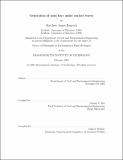Generation of sand bars under surface waves
Author(s)
Hancock, Matthew James, 1975-
DownloadFull printable version (6.830Mb)
Other Contributors
Massachusetts Institute of Technology. Dept. of Civil and Environmental Engineering.
Advisor
Chiang C. Mei.
Terms of use
Metadata
Show full item recordAbstract
(cont.) Experiments were performed in a large wave flume to validate the theory and to study additional aspects of sand bar evolution. The wave envelope and bar profile were recorded for low and high beach reflection, monochromatic and polychromatic waves, and several sediment grain sizes. In particular, sediment sorting was demonstrated under standing waves when the seabed consisted of initially well mixed sand of two grain sizes. A quantitative theory is described for the evolution of sand bars under monochromatic surface water waves. By assuming the slopes of the waves and seabed are comparably gentle, an approximate evolution equation is found for the seabed elevation. The boundary layer structure is calculated by assuming a depth-linear or depth-independent time-invariant eddy viscosity. An empirical formula by Sleath (1978) is used to predict the bedload transport. A convective diffusion equation governs the suspended sediment transport (which includes the effects of wave-advection), and empirical formulae by Lee et al. (2004) and Wikramanayake & Madsen (1994) specify the time-varying concentration at the seabed. Effects of mean beach slope and narrow banded waves are also considered. The sand bar elevation is found to evolve according to a forced-diffusion equation, where the diffusivity is the gravitational effect on bedload transport on a slope and the forcing is due to both bedload and suspended load transport mechanisms. The time scale of sand bar evolution is over four orders of magnitude longer than the wave period: days in the lab and weeks in the field. In addition to the effects of bedload considered before by Yu & Mei (2000), it is found that suspended load provides a new forcing mechanism affecting sand bar geometry when the seabed is composed of fine sediments. When wave reflection is significant, bars and waves interact through the Bragg scattering mechanism. Under strong reflection, large regions exist where there is no change to the seabed. For weaker reflection, an inviscid return flow is present that places an additional stress on the bed. As shown by Yu & Mei (2000), any finite beach reflection is sufficient to generate and maintain sand bars.
Description
Thesis (Ph. D.)--Massachusetts Institute of Technology, Dept. of Civil and Environmental Engineering, 2005. This electronic version was submitted by the student author. The certified thesis is available in the Institute Archives and Special Collections. Includes bibliographical references (p. 277-282).
Date issued
2005Department
Massachusetts Institute of Technology. Department of Civil and Environmental EngineeringPublisher
Massachusetts Institute of Technology
Keywords
Civil and Environmental Engineering.